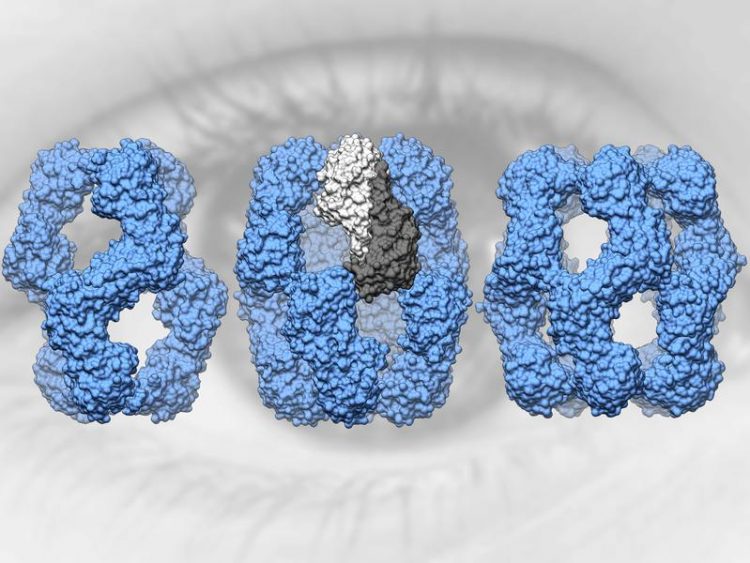Protective protein in the eye lens affects protein oxidation: Guardian angel of the eye

Human alpha-A crystallin forms structures of 12, 16 and 20 subunits (from left to right). Two subunits (center, dark and light gray) form a dimer. Image: C. Kaiser / TUM
The refractive power of the human eye lens stems from a highly concentrated protein solution. These proteins are created during embryonic development and must then function for a whole life, as the lens has no machinery to synthesize or degrade proteins.
When lens proteins are damaged, the result is cataract – a clouding of the lens – or presbyopia. This is where protective proteins come in: They ensure that the proteins of the eye retain their form even under adverse environmental influences.
“The two protective proteins alpha-A and alpha-B crystallin make up around 30 percent of the proteins in the human eye and are extremely important for the function of the lens,” says Christoph Kaiser, first author of the publication in the journal Nature Structural and Molecular Biology.
Structure of a multifaceted protein
Attempts to determine the structure of alpha-A crystallin were unsuccessful for over 40 years. The breakthrough came for a research team led by the TUM professors Sevil Weinkauf, professor of electron microscopy and Johannes Buchner, professor of biotechnology, by combining cryo-electron microscopy, mass spectrometry, NMR spectroscopy and molecular modeling.
“Alpha-A crystalline is extremely multifaceted,” says Sevil Weinkauf. “This makes it very difficult to determine its structure. It was only after developing a new strategy for data analysis that we were able to demonstrate that in solution it takes on different structures with 12, 16 or 20 subunits.”
Protection against oxidation
The typical function of protective proteins is to help other proteins maintain their form when stressed, by high temperatures, for example. This is why they are also referred to as chaperones.
Alpha-A and alpha-B crystallin, too, have this function. In addition, human alpha-A crystallin has two cysteine residues. The sulfur atoms in these residues can form disulfide bridges. In-depth biochemical studies have shown that this bridging has a significant impact on various properties of the protein molecule.
“A common theory is that the disulfide bridges result from damage to the protein, for example through oxygen,” says Johannes Buchner. “Our results suggest that alpha-A crystallin might play an active role in protecting other proteins from oxidation.”
Motivation for further research
The research team's investigations demonstrate that oxidized alpha-A crystallin can even transfer the existing disulfide bridge to other proteins. “This ability corresponds to that of a protein disulfide oxidase,” says Christoph Kaiser. “Alpha-A crystallin can thus influence the redox state of other lens proteins. This function also explains why roughly half of the alpha-A crystallins in embryos already have such disulfide bridges.”
“Around 35 percent of all cases of blindness can be attributed to cataracts, says Sevil Weinkauf. “The molecular understanding of the functions of eye lens proteins forms an essential basis for developing prevention and therapy strategies. The realization that alpha-A crystallin also plays an important role in protecting against oxidation will now spawn further research.”
Further information:
The research was funded by the German Research Foundation (SFB 1035 and Cluster of Excellence Center for Integrated Protein Science Munich) and the Wellcome Trust. Scientists from TU Munich, the Institute of Structural Biology at Helmholtz Zentrum München, the Institute for Biotechnology at the Technical University of Berlin and the Wellcome Center for Cell Biology at the University of Edinburgh (UK) participated in the research.
Prof. Dr. Sevil Weinkauf
Professorship of Electron Microscopy
Technical University of Munich
Lichtenbergstr. 4, 85748 Garching, Germany
Tel.: +49 89 289 13517 – E-Mail: sevil.weinkauf@ch.tum.de
Web: https://www.department.ch.tum.de/en/em/home/
Christoph J. O. Kaiser, Carsten Peters, Philipp W. N. Schmid, Maria Stavropoulou, Juan Zou, Vinay Dahiya, Evgeny V. Mymrikov, Beate Rockel, Sam Asami, Martin Haslbeck, Juri Rappsilber, Bernd Reif, Martin Zacharias, Johannes Buchner & Sevil Weinkauf
The structure and oxidation of the eye lens chaperone αA-crystallin
Nature Structural & Molecular Biology vol. 26, 1141–1150 (2019) – DOI: 10.1038/s41594-019-0332-9
Link: https://www.nature.com/articles/s41594-019-0332-9
https://www.tum.de/nc/en/about-tum/news/press-releases/details/35879/ Link to the press release
Media Contact
All latest news from the category: Life Sciences and Chemistry
Articles and reports from the Life Sciences and chemistry area deal with applied and basic research into modern biology, chemistry and human medicine.
Valuable information can be found on a range of life sciences fields including bacteriology, biochemistry, bionics, bioinformatics, biophysics, biotechnology, genetics, geobotany, human biology, marine biology, microbiology, molecular biology, cellular biology, zoology, bioinorganic chemistry, microchemistry and environmental chemistry.
Newest articles

Superradiant atoms could push the boundaries of how precisely time can be measured
Superradiant atoms can help us measure time more precisely than ever. In a new study, researchers from the University of Copenhagen present a new method for measuring the time interval,…

Ion thermoelectric conversion devices for near room temperature
The electrode sheet of the thermoelectric device consists of ionic hydrogel, which is sandwiched between the electrodes to form, and the Prussian blue on the electrode undergoes a redox reaction…

Zap Energy achieves 37-million-degree temperatures in a compact device
New publication reports record electron temperatures for a small-scale, sheared-flow-stabilized Z-pinch fusion device. In the nine decades since humans first produced fusion reactions, only a few fusion technologies have demonstrated…





















